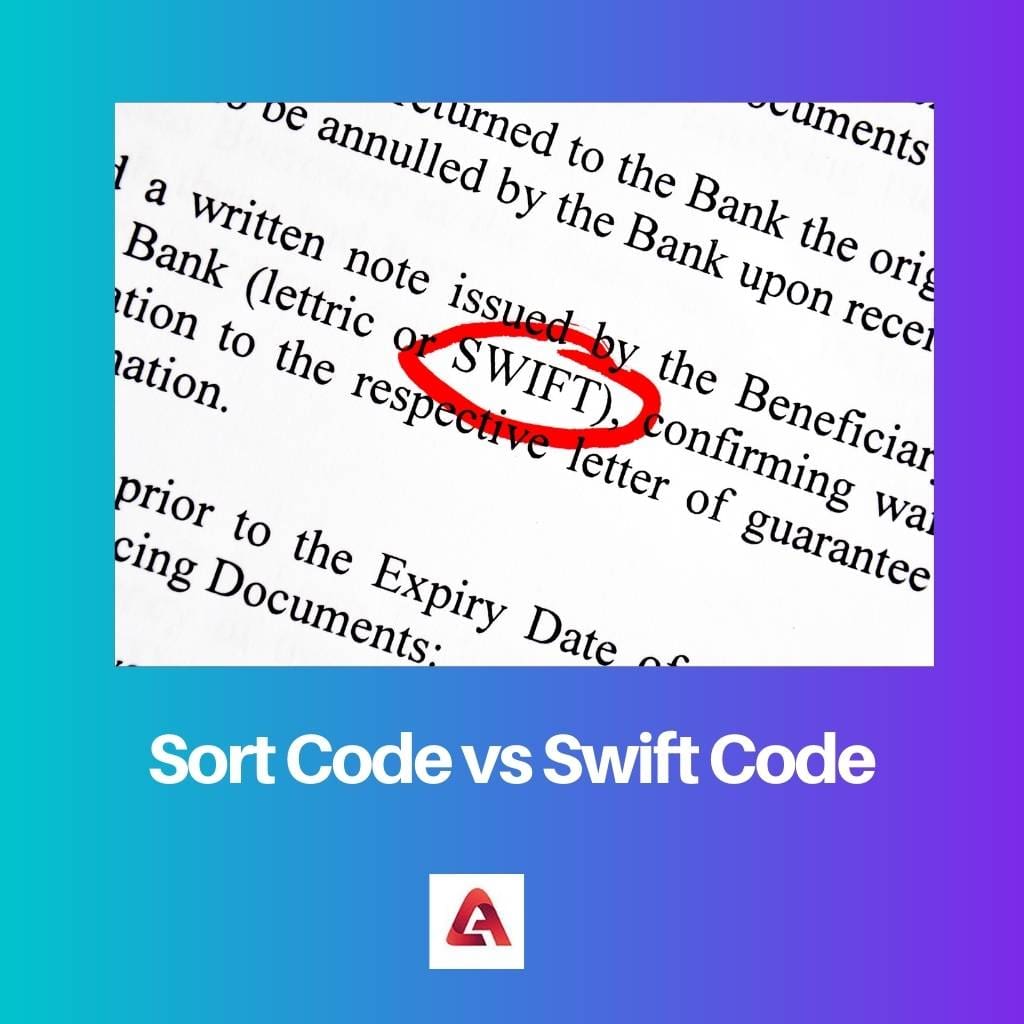Sort code is a numerical code used primarily in the United Kingdom and Ireland to identify individual branches of banks or financial institutions for domestic transactions within those countries. In contrast, Swift code, also known as Bank Identifier Code (BIC), is an internationally recognized alphanumeric code utilized for identifying specific banks or financial institutions in cross-border transactions, ensuring seamless communication and secure transfer of funds globally.
Key Takeaways
- Sort Code and Swift Code are banking codes used to identify specific financial institutions and facilitate international transactions.
- Sort Code is a six-digit number used in the UK and Ireland, while Swift Code is an alphanumeric code used globally.
- While Sort Code is used for domestic transactions, Swift Code is necessary for international transactions and can be used for incoming and outgoing transfers.
Sort Code vs Swift Code
The difference between Sort Code and Swift Code is that Sort Code is used for only domestic transfers, whereas Swift Code is used for international safe transactions.

Sort Code is a 6-digit numeric code used for domestic transactions in England and parts of Ireland. These digits help to identify the bank and the branch for the transaction.
Swift Code is an 11-digit alphanumeric code that is used for international transfers. These codes are used for identifying the bank and country of the branch. They also show the location and the branch, but the branch code can be omitted during primary transfers to make it an 8-digit code.
Comparison Table
| Feature | Sort Code | Swift Code (BIC) |
|---|---|---|
| Purpose | Identify specific bank branches within a country | Identify specific banks internationally |
| Region of Use | Primarily used in the UK and Ireland | Used globally |
| Number of digits | 6 digits (formatted as XX-XX-XX) | 8 or 11 alphanumeric characters |
| Information contained | Branch code and bank identification number | Bank identification code, country code, and optional location code |
| Use case | Required for domestic bank transfers within the UK and Ireland | Required for international bank transfers (wire transfers) between any two banks globally |
| Regulation | Regulated by the UK Payments Council and the Central Bank of Ireland | Regulated by the Society for Worldwide Interbank Financial Telecommunication (SWIFT) |
What is the Sort Code?
The Sort Code is a unique numerical code utilized primarily in the United Kingdom and Ireland for identifying individual branches of banks or financial institutions. It plays a crucial role in domestic financial transactions, facilitating the smooth processing of payments, transfers, and other banking activities within these regions.
Structure and Function
The Sort Code consists of six digits and is structured in a specific format to denote various information about the bank branch it represents. The first two digits of the Sort Code identify the bank itself, while the next two digits specify the specific location or city of the branch. The final two digits indicate the individual branch of the bank.
This hierarchical structure allows for precise identification of bank branches across the country, ensuring accuracy and efficiency in processing transactions. Each bank branch is assigned a unique Sort Code, enabling seamless communication and coordination within the banking system.
Importance in Banking Operations
- Payment Processing: Sort Codes are essential for routing payments and transfers accurately to the intended recipient’s bank branch.
- Direct Debits and Standing Orders: When setting up direct debits or standing orders, individuals and businesses must provide their bank’s Sort Code to ensure payments are directed to the correct branch.
- Cheque Processing: Sort Codes are utilized in cheque processing to determine the bank branch where the cheque should be deposited or from which it was issued.
- Account Verification: Financial institutions use Sort Codes to verify account details and ensure the legitimacy of transactions.
Evolution and Modern Usage
While originally designed for manual processing, Sort Codes are now predominantly used in electronic banking systems. With advancements in technology, Sort Codes are seamlessly integrated into online banking platforms, payment gateways, and other digital financial services, enhancing speed, accuracy, and security in banking operations. Despite the evolution of banking technology, the Sort Code remains a fundamental element of the UK and Ireland’s banking infrastructure, ensuring efficient and reliable financial transactions.

What is the Swift Code?
A Swift Code, also known as a Bank Identifier Code (BIC), is a globally recognized alphanumeric code used to identify specific banks or financial institutions in international transactions. Developed and maintained by the Society for Worldwide Interbank Financial Telecommunication (SWIFT), this standardized code ensures secure and efficient communication between financial institutions worldwide.
Structure and Function
- Bank Code (4 characters): The first four characters of the Swift Code represent the bank’s unique identifier or bank code. This component identifies the specific bank or financial institution involved in the transaction.
- Country Code (2 characters): The next two characters denote the country where the bank is located. This component helps in identifying the country where the financial institution is registered or operates.
- Location Code (2 characters): Following the country code, the Swift Code includes two characters that specify the location of the bank within the country. This component aids in identifying the city or region where the bank is situated.
- Branch Code (Optional, 3 characters): In some cases, the Swift Code may include an optional three-character branch code. This component further refines the identification of a specific branch of the bank.
Importance in International Transactions
- Cross-Border Payments: Swift Codes are used to route international wire transfers and payments securely between banks across different countries. Each Swift Code ensures that funds are directed accurately to the intended recipient’s bank account.
- Foreign Exchange Transactions: In foreign exchange transactions, Swift Codes help identify the banks involved in currency exchange, enabling seamless transfer of funds between accounts held in different currencies.
- Trade Finance: Swift Codes are utilized in trade finance transactions, such as letters of credit and documentary collections, to identify the banks acting as intermediaries and facilitate smooth trade operations between buyers and sellers across borders.
- Interbank Communication: Financial institutions use Swift Codes for secure interbank communication, including messaging related to fund transfers, account inquiries, and other banking operations.
Evolution and Modern Usage
Since its inception in the 1970s, Swift Codes have become an essential component of the global banking infrastructure. With the advent of electronic banking systems and the expansion of international trade and finance, Swift Codes have evolved to support faster, more secure, and efficient cross-border transactions. Today, Swift Codes are integrated into various banking channels, including online banking platforms, mobile applications, and electronic payment networks, enabling seamless connectivity and interoperability among financial institutions worldwide.

Main Differences Between Sort Code and Swift Code
- Geographical Scope:
- Sort Code: Used primarily in the United Kingdom and Ireland for domestic transactions.
- Swift Code: Used globally for international transactions, facilitating communication between banks worldwide.
- Structure:
- Sort Code: Consists of six digits, identifying the bank branch within the UK or Ireland.
- Swift Code: Alphanumeric code, 8 to 11 characters long, providing information about the bank’s identity, country, location, and optionally, branch.
- Function:
- Sort Code: Used for routing payments, direct debits, standing orders, and cheque processing within the UK and Ireland.
- Swift Code: Used for identifying banks in international wire transfers, foreign exchange transactions, trade finance, and interbank communication globally.
- Regulatory Authority:
- Sort Code: Governed by national banking regulations in the UK and Ireland.
- Swift Code: Developed and maintained by the Society for Worldwide Interbank Financial Telecommunication (SWIFT), an international cooperative organization.


